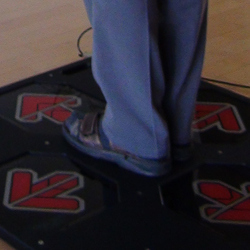Enhancing brain through motor learning and nutrition
The aim of the project is to investigate changes of the brain dopamine system in elderly due to VR driven training with and without dietary intervention. Molecular imaging using RAC-positron emission tomography (PET) will allow direct assessment of the brain dopamine system pre- and post-intervention. This project will contribute to the success of D-HEST through integration of complementary expertise in human movement and nutrition sciences together with biomedical technology to design health strategies to prevent brain related gait disorders of elderly. We expect that this new approach will provide new insights into the mechanisms of the interaction of exercise and nutrition on brain synaptogenesis. These will translate into well-defined optimal combinations of exercise and nutrition for prevention of mobility loss in elderly, in order to reduce the risk of falls and fractures, and contribute to healthy aging.

In the growing population of older people, falling is a common problem. Approximately 30% of older adults experience a fall each year, and fall incidence is even higher (50%) in women aged 85 and above. The motor cortex contains several distinct areas in the frontal lobes which receive inputs from sensory pathways, motor control structures and modulatory pathways including the thalamus and Basal Ganglia. This cluster of architectonically distinct frontal fields is fundamentally involved in movement planning and performance; with the most widely recognized fields being the primary motor cortex (M1) the pre-motor area (PMA) and the supplementary motor area (SMA). There are indications that the influence of motor and sensory impairments on falls is in part moderated by executive functioning.
Computer games have the potential to train cognitive functions, including attention and executive functions, because the brain is able to reorganize in response to behavior. Physical exercise performed in virtual reality (VR) environments may specifically include motor learning enhancing features. Recent research indicates that the effects of physical exercise on the brain can be enhanced by concurrent consumption of natural products. The potential synergy between diet and exercise could involve common cellular pathways important for neurogenesis, cell survival, synaptic plasticity and vascular function.
The aim of the project is to investigate changes of the brain dopamine system in elderly due to VR driven training with and without dietary intervention. Molecular imaging using RAC-positron emission tomography (PET) will allow direct assessment of the brain dopamine system pre- and post-intervention. This project will contribute to the success of D-HEST through integration of complementary expertise in human movement and nutrition sciences together with biomedical technology to design health strategies to prevent brain related gait disorders of elderly. We expect that this new approach will provide new insights into the mechanisms of the interaction of exercise and nutrition on brain synaptogenesis. These will translate into well-defined optimal combinations of exercise and nutrition for prevention of mobility loss in elderly, in order to reduce the risk of falls and fractures, and contribute to healthy aging.
Funding
This work was supported by the ETH Foundation through ETH Research Grant ETH- 17 13-2